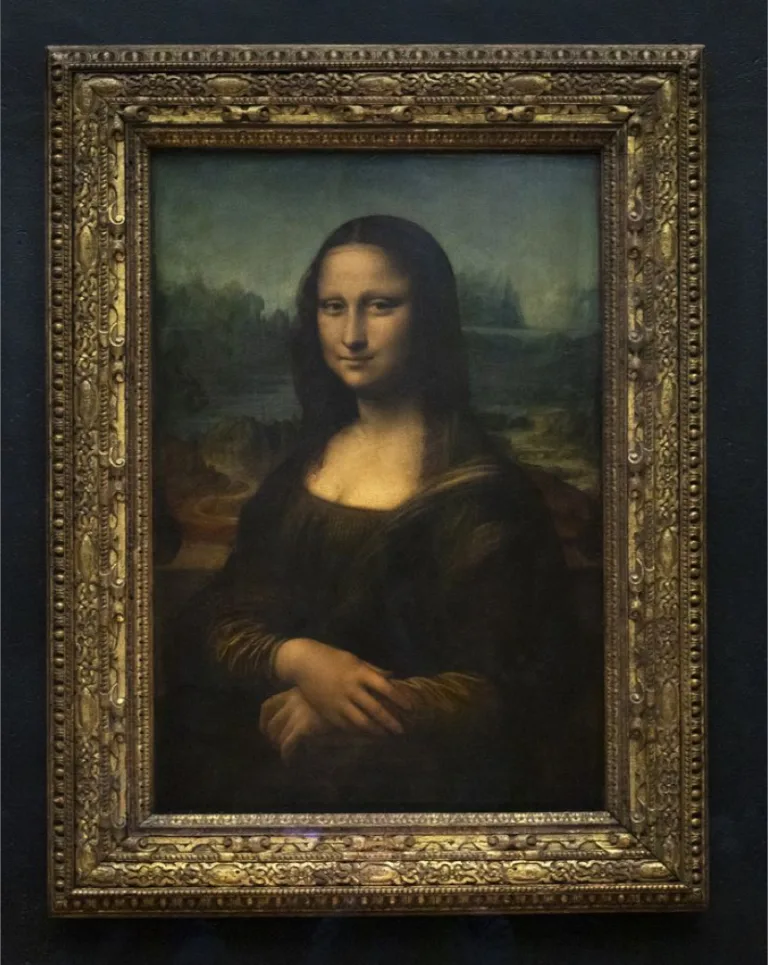Here is a list of 10 iconic paintings that are widely recognized and celebrated for their artistic merit:
1.Mona Lisa
2.The Starry Night
3.The Last Supper
4.The Scream
5.Guernica
6.Girl with a Pearl Earring
7.The Persistence of Memory
8.The Birth of Venus
9.The Creation of Adam
10.The Night Watch
1.Mona Lisa
Artist: Leonardo da Vinci
The Mona Lisa, painted by Leonardo da Vinci, is regarded as the most famous painting in the world.
- Artist: Leonardo da Vinci is one of the most renowned artists of all time, and his mastery is evident in the Mona Lisa. His contributions to art, science, and engineering have cemented his legacy as a polymath, with the Mona Lisa being his most celebrated work.
- Subject: The painting is a portrait of a woman, widely believed to be Lisa Gherardini, a Florentine woman and wife of wealthy merchant Francesco del Giocondo. The identity of the sitter has contributed to the painting’s mystique and intrigue.
- Technique: Leonardo’s use of sfumato, a technique that creates a soft, gradual transition between colors and tones, is masterfully employed in the Mona Lisa. This technique gives the painting its lifelike quality and depth, particularly in the rendering of the sitter’s face.
- Expression: The enigmatic expression of the Mona Lisa is one of the most discussed aspects of the painting. Her subtle smile and ambiguous expression have captivated viewers for centuries, prompting endless speculation and interpretation.
- Composition: The composition of the painting, with the subject seated against an imaginary landscape, showcases Leonardo’s skill in creating a balanced and harmonious work. The use of atmospheric perspective in the background adds to the sense of depth and realism.
- Historical Context: Painted in the early 16th century during the Italian Renaissance, the Mona Lisa embodies the artistic advancements of the period. It reflects the era’s focus on humanism, naturalism, and the study of anatomy and perspective.
- Location: The Mona Lisa is housed in the Louvre Museum in Paris, one of the most visited and prestigious museums in the world. Its prominent display in the Louvre attracts millions of visitors each year, further cementing its status as an iconic masterpiece.
- Theft and Recovery: The painting gained immense international fame after it was stolen from the Louvre in 1911 and recovered in 1913. The theft and subsequent media coverage significantly boosted its public profile and added to its mystique.
- Cultural Impact: The Mona Lisa has permeated popular culture, inspiring countless reproductions, parodies, and references in various media. Its image is instantly recognizable, making it a cultural icon beyond the art world.
- Scientific Analysis: Over the years, the Mona Lisa has been the subject of extensive scientific analysis, including infrared and X-ray examinations. These studies have revealed insights into Leonardo’s techniques, the painting’s condition, and its history, adding to its intrigue.
- Symbolism: The Mona Lisa is often seen as a symbol of artistic achievement and the embodiment of Renaissance ideals. It represents the fusion of art and science, reflecting Leonardo’s multifaceted genius.
- Mystique and Legend: The painting’s long history, combined with its mysterious qualities, has generated numerous legends and conspiracy theories. These stories, ranging from hidden messages to secret identities, contribute to its enduring fascination.
- Artistic Influence: The Mona Lisa has influenced countless artists and has been referenced in a wide range of artistic movements and styles. Its impact on art history is profound, with many artists studying and emulating Leonardo’s techniques.
- Preservation and Care: The painting is carefully preserved and protected, reflecting its status as a priceless cultural treasure. The measures taken to safeguard it, including a climate controlled display case and bulletproof glass, highlight its value and importance.
- Public Engagement: The Mona Lisa continues to engage the public and provoke discussion. It remains a focal point for debates on art, aesthetics, and the nature of beauty, ensuring its relevance and prominence in the art world.
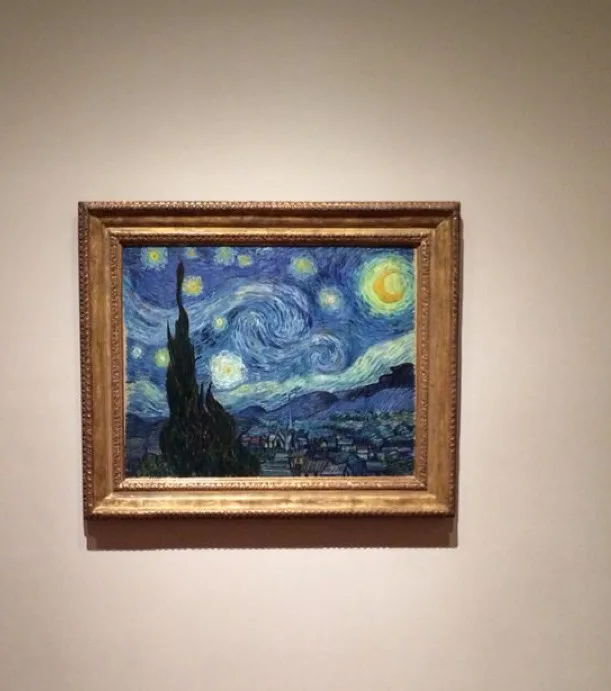
2.The Starry Night
Artist: Vincent van Gogh
The Starry Night by Vincent van Gogh is one of the most famous paintings in the world.
- Artist: Vincent van Gogh is one of the most celebrated and influential artists in history. Despite his struggles with mental illness and lack of recognition during his lifetime, his work has had a profound impact on the art world. Van Gogh’s distinctive style and emotional intensity are exemplified in The Starry Night.
- Visual Impact: The Starry Night is renowned for its swirling, turbulent depiction of the night sky. Van Gogh’s bold use of color, dynamic brushstrokes, and expressive forms create a mesmerizing and otherworldly scene that captivates viewers.
- Composition: The painting features a village under a starry sky, with a cypress tree in the foreground and rolling hills in the background. The composition balances tranquility with movement, and the interplay of the luminous stars and moon against the dark sky creates a striking contrast.
- Emotional Depth: The Starry Night is often interpreted as a reflection of Van Gogh’s emotional state and inner turmoil. The painting conveys a sense of awe and wonder, but also a deep melancholy. This emotional depth resonates with viewers and adds to its universal appeal.
- Historical Context: Van Gogh painted The Starry Night in 1889 while he was living in the Saint-Paul-de-Mausole asylum in Saint-Rémy-de-Provence, France. The painting is believed to depict the view from his window, infused with his vivid imagination and emotional intensity.
- Symbolism: The elements in The Starry Night are rich with symbolism. The swirling sky can be seen as a representation of Van Gogh’s turbulent mind, while the cypress tree, often associated with death and eternity, adds a poignant touch. The village, with its peaceful houses and church, contrasts with the dynamic sky, suggesting a longing for stability and solace.
- Innovative Technique: Van Gogh’s use of impasto (thick layers of paint) and his distinctive, rhythmic brushstrokes give The Starry Night a unique texture and sense of movement. His innovative techniques have inspired countless artists and have become a hallmark of his style.
- Cultural Influence: The Starry Night has permeated popular culture and is widely referenced in literature, music, film, and other art forms. Its iconic status makes it instantly recognizable, and it continues to inspire and influence new generations of artists and art lovers.
- Artistic Legacy: The Starry Night is a quintessential example of Post Impressionism, a movement characterized by a focus on emotional expression and the use of vivid colors and bold forms. Van Gogh’s work paved the way for modern art movements and remains a touchstone for exploring the power of artistic expression.
- Public Display and Access: The painting is housed in the Museum of Modern Art (MoMA) in New York City, where it is a major attraction. Its accessibility to the public has allowed millions of people to experience its beauty firsthand, further solidifying its fame.
- Emotional Connection: The Starry Night resonates with people on a personal level. Its depiction of the natural world infused with emotional intensity speaks to the human experience, evoking feelings of wonder, introspection, and connection to something greater.
- Popularity and Reproduction: The Starry Night is one of the most reproduced and recognizable artworks in the world. Its image is featured on posters, merchandise, and digital platforms, making it accessible to a broad audience and cementing its place in popular culture.
- Critical Acclaim: Art critics and historians have long celebrated The Starry Night for its technical mastery and emotional depth. It is frequently cited in discussions of Van Gogh’s genius and the transformative power of his work.
- Educational Importance: The painting is widely studied in art education programs, where it serves as a prime example of Van Gogh’s innovative style and the broader Post Impressionist movement. Its inclusion in curricula ensures that it continues to influence and inspire future artists.
- Enduring Mystery: The Starry Night retains an air of mystery and intrigue. The exact meaning of the swirling patterns and the emotions behind the painting are open to interpretation, inviting viewers to engage with the artwork on a deeply personal level.
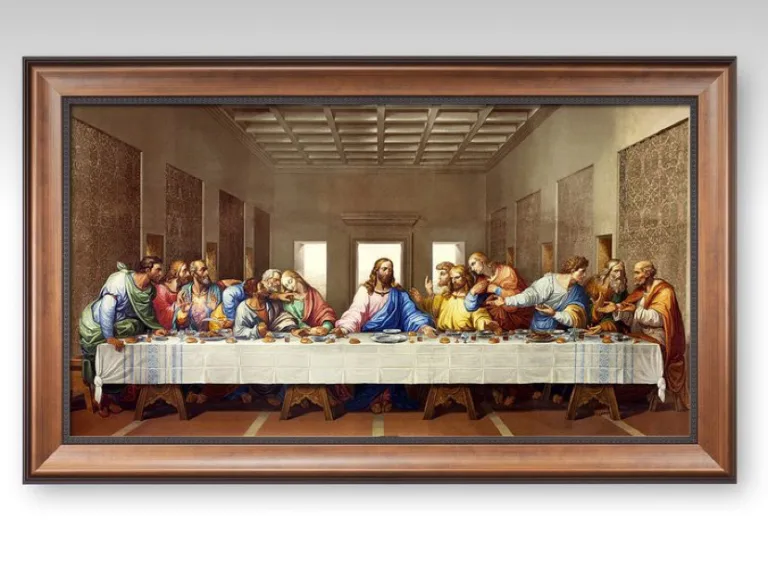
3.The Last Supper
Artist: Leonardo da Vinci
The Last Supper by Leonardo da Vinci is one of the most famous and iconic paintings in the world.
- Artist: Leonardo da Vinci, one of the greatest artists and thinkers of the Renaissance, painted The Last Supper. His contributions to art, science, and engineering have left an indelible mark on history, and The Last Supper is one of his most celebrated works.
- Historical Context: Painted between 1495 and 1498, The Last Supper is located in the Convent of Santa Maria delle Grazie in Milan, Italy. It was commissioned by Ludovico Sforza, Duke of Milan, for the convent’s refectory.
- Subject Matter: The painting depicts the moment Jesus announces that one of his disciples will betray him. This dramatic scene is taken from the Gospel of John and is one of the most significant events in Christian theology.
- Composition: Leonardo’s composition is masterful. He organizes the twelve disciples into groups of three, capturing their varied reactions to Jesus’ announcement. The use of linear perspective draws the viewer’s eye to the central figure of Jesus, who is positioned at the vanishing point, emphasizing his importance.
- Emotional Expression: Each disciple’s reaction is uniquely rendered, showing a range of emotions from shock and disbelief to sorrow and anger. Leonardo’s ability to capture these nuanced expressions adds to the painting’s emotional depth and realism.
- Innovative Technique: Leonardo used an experimental technique to create The Last Supper, applying tempera and oil paint on a dry plaster wall rather than using traditional fresco methods. While this allowed for greater detail and color variation, it also made the painting more vulnerable to deterioration.
- Symbolism: The Last Supper is rich with symbolic elements. The use of light and shadow, the positioning of the disciples, and the inclusion of symbolic items like bread and wine all contribute to the painting’s theological and artistic depth.
- Restoration Efforts: Over the centuries, The Last Supper has suffered significant damage and undergone multiple restoration efforts. The most recent restoration, completed in 1999, aimed to preserve as much of Leonardo’s original work as possible, despite the challenges posed by the painting’s fragile condition.
- Cultural Impact: The Last Supper has had a profound influence on art and culture. It has been referenced and reinterpreted in countless works of literature, film, and art. Its imagery is deeply ingrained in Western culture and is instantly recognizable.
- Technological Advancements: Advances in technology, including high resolution imaging and digital restoration techniques, have allowed for a deeper understanding and appreciation of The Last Supper. These tools have revealed details and insights that were previously hidden.
- Educational Importance: The Last Supper is widely studied in art history and theology courses. It serves as an exemplary case for examining Renaissance art, Leonardo’s techniques, and the intersection of art and religious narrative.
- Public Engagement: The painting attracts millions of visitors each year, despite the need for restricted access to protect its delicate state. The viewing experience in the refectory of Santa Maria delle Grazie is considered a pilgrimage for art lovers and scholars.
- Artistic Influence: Leonardo’s depiction of The Last Supper has influenced countless artists, from Renaissance contemporaries to modern painters. Its composition, use of perspective, and emotional depth continue to inspire new generations of artists.
- Mystique and Intrigue: The Last Supper has been the subject of numerous theories and interpretations, some of which have entered popular culture. For example, Dan Brown’s novel “The Da Vinci Code” brought widespread attention (and controversy) to hidden symbols and supposed secrets within the painting.
- Legacy: The Last Supper remains a testament to Leonardo da Vinci’s genius and the enduring power of great art. Its ability to convey profound theological themes, capture human emotion, and innovate in technique ensures its place as one of the most revered works in the history of art.

4.The Scream
Artist: Edvard Munch
The Scream by Edvard Munch is one of the most famous and iconic paintings in the world.
- Artist: Edvard Munch, a Norwegian painter and printmaker, created The Scream. Munch is a prominent figure in the Symbolist and Expressionist movements, known for his emotionally charged and symbolically rich works.
- Multiple Versions: Munch created several versions of The Scream, including two paintings, two pastels, and a number of lithographs. The most famous painted version was created in 1893. The multiple versions have contributed to the painting’s widespread recognition.
- Emotional Impact: The Scream is renowned for its raw portrayal of human anxiety and existential angst. The central figure’s agonized expression and the swirling, tumultuous background convey a powerful sense of psychological distress and turmoil.
- Symbolism: The painting is rich in symbolic meaning. The figure’s scream represents a cry of existential despair, while the swirling sky and distorted landscape reflect the internal chaos and anxiety of modern life. The use of bold colors and dynamic lines enhances the painting’s emotional intensity.
- Historical Context: Created during a time of great social and psychological upheaval in the late 19th and early 20th centuries, The Scream captures the existential anxieties of the modern era. It reflects the broader themes of alienation, fear, and anxiety that were prevalent in society.
- Innovative Technique: Munch’s use of vivid colors, swirling lines, and dramatic composition was innovative and influential. His technique broke away from traditional representational art and paved the way for the Expressionist movement, which emphasized emotional experience over realistic depiction.
- Cultural Influence: The Scream has permeated popular culture and is widely referenced in literature, film, music, and other art forms. Its image is instantly recognizable and has become a symbol of existential angst and modern psychological struggle.
- Theft and Recovery: The Scream has been the target of several high profile thefts, including in 1994 and 2004. Its theft and subsequent recoveries have added to its mystique and public interest.
- Public Display: The various versions of The Scream are displayed in prominent museums, including the National Gallery in Oslo and the Munch Museum. These institutions attract numerous visitors who come to view this iconic work.
- Reproductions and Parodies: The Scream has been widely reproduced and parodied, making it one of the most familiar images in the world. Its reproductions on posters, merchandise, and digital platforms have further solidified its place in popular culture.
- Artistic Legacy: The Scream has had a profound influence on modern art, particularly the Expressionist movement. Artists have drawn inspiration from Munch’s emotional intensity and innovative use of color and form.
- Psychological Resonance: The Scream resonates deeply with viewers due to its portrayal of universal human emotions. Its depiction of fear, anxiety, and despair strikes a chord with many people, making it a powerful and enduring work.
- Critical Acclaim: Art critics and historians have long celebrated The Scream for its emotional depth and technical innovation. It is frequently cited in discussions of Munch’s genius and the broader trends in modern art.
- Symbol of Modernity: The Scream is often seen as a symbol of modernity and the existential crises that come with it. Its portrayal of the individual’s struggle against overwhelming emotions and societal pressures remains relevant to contemporary audiences.
- Enduring Mystery: Thepainting retains an air of mystery and intrigue. The exact inspiration for the central figure’s scream and the meaning behind the painting’s elements are open to interpretation, inviting viewers to engage with the artwork on a personal level.
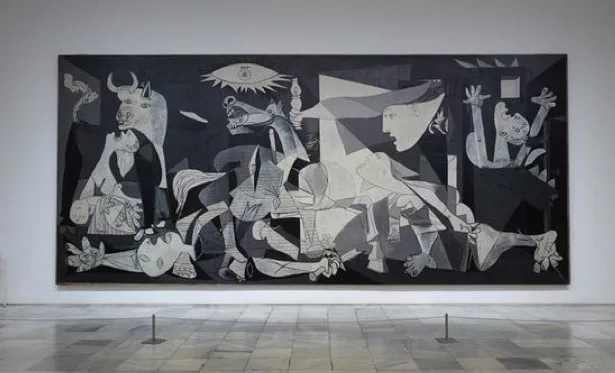
5.Guernica
Artist: Pablo Picasso
Guernica by Pablo Picasso is one of the most famous and significant paintings in the world.
- Artist: Pablo Picasso, one of the most influential artists of the 20th century, created Guernica. Picasso is renowned for his contributions to modern art, particularly for co-founding the Cubist movement and for his innovative approaches to form and composition.
- Historical Context: Painted in 1937, Guernica was created in response to the bombing of the Basque town of Guernica during the Spanish Civil War by Nazi German and Italian Fascist forces allied with Francisco Franco. The attack resulted in widespread destruction and civilian casualties, shocking the world.
- Commission: The painting was commissioned by the Spanish Republican government for the Spanish Pavilion at the 1937 Paris International Exposition (World’s Fair) to draw attention to the atrocities occurring in Spain and to garner international support against Franco’s regime.
- Anti-War Message: Guernica serves as a powerful anti-war statement, depicting the horrors and tragedies of war and the suffering it inflicts upon innocent civilians. The painting has become an enduring symbol of peace and a poignant reminder of the brutality of conflict.
- Composition and Technique: Guernica is notable for its large scale (approximately 11 feet tall and 25.6 feet wide) and its monochromatic palette of black, white, and grey. Picasso’s use of Cubist techniques, fragmented forms, and distorted figures effectively conveys chaos and destruction.
- Symbolism: The painting is filled with symbolic elements. The central figure of a horse, a bull, a grieving woman holding a dead child, and other distressed figures convey a sense of agony and despair. The disjointed, nightmarish quality of the imagery captures the brutality of the bombing and its impact on human lives.
- Cultural and Political Impact: Guernica has had a profound cultural and political impact. It has been used as a powerful tool for political activism and social commentary, speaking out against the horrors of war and oppression. Its influence extends beyond art, resonating with political and social movements around the world.
- Exile and Return: After the Paris Exposition, Guernica toured various countries, raising awareness about the Spanish Civil War. It was then kept at the Museum of Modern Art (MoMA) in New York for safekeeping during World War II and the subsequent Franco dictatorship. Picasso stipulated that the painting should not return to Spain until democracy was restored. It was finally returned to Spain in 1981 and is now housed in the Museo Reina Sofía in Madrid.
- Public Display: Guernica attracts millions of visitors each year and remains one of the most significant and visited works of art. Its presence in the Museo Reina Sofía provides an opportunity for people to engage with its powerful message and historical context.
- Emotional Resonance: The raw emotional power of Guernica resonates with viewers on a deep level. Its depiction of human suffering and the indiscriminate violence of war evokes a strong emotional response, making it a deeply moving and impactful work.
- Artistic Legacy: Guernica has had a lasting influence on contemporary art and artists. Its innovative use of form and symbolism, as well as its potent political message, continue to inspire and challenge artists and audiences.
- Scholarly Study: The painting has been extensively studied by art historians, scholars, and critics. Its complex symbolism, historical context, and artistic techniques have been the subject of numerous analyses and interpretations.
- Symbol of Resistance: Over time, Guernica has become a universal symbol of resistance against tyranny and injustice. Its powerful imagery continues to be used in protests and movements advocating for peace and human rights.
- Technological Advances: Advances in digital technology and imaging have allowed for detailed studies of Guernica, providing deeper insights into Picasso’s creative process and the painting’s intricate details.
- Enduring Relevance: Guernica remains relevant today as a testament to the enduring impact of war on humanity. Its message transcends time and place, reminding us of the devastating consequences of violence and the importance of striving for peace.
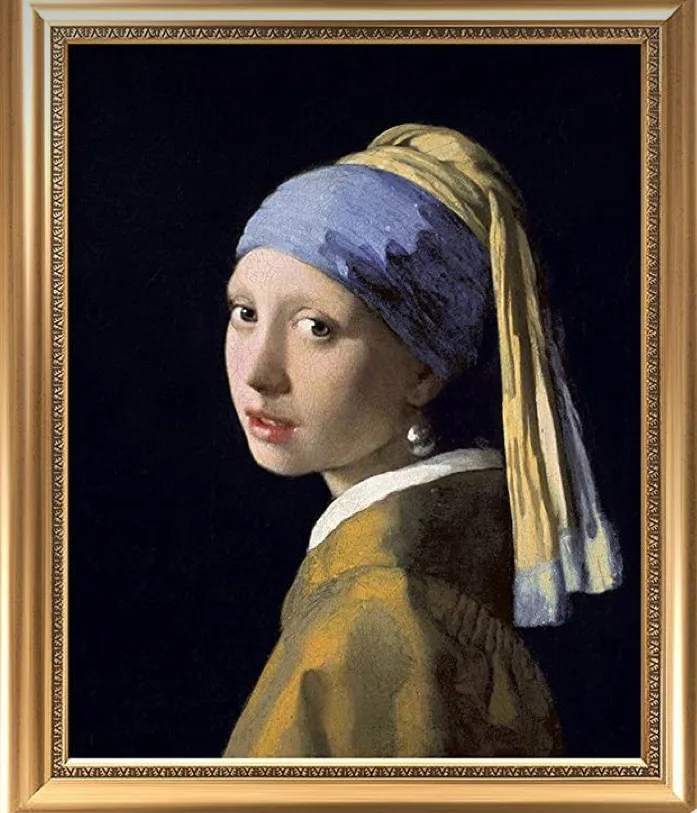
6.Girl with a Pearl Earring
Artist: Johannes Vermeer
Girl with a Pearl Earring by Johannes Vermeer is one of the most famous and beloved paintings in the world.
- Artist: Johannes Vermeer, a Dutch painter from the 17th century, created Girl with a Pearl Earring. Vermeer is renowned for his masterful use of light and color, and his ability to capture intimate moments and domestic scenes.
- Creation and Date: Painted around 1665, the work is one of Vermeer’s most admired pieces. The exact circumstances of its creation and the identity of the model remain subjects of speculation, adding to the painting’s mystique.
- Subject: The painting features a young girl wearing an exotic dress, an oriental turban, and an oversized pearl earring. Unlike traditional portraits, this work is often referred to as a “tronie,” a Dutch term for a character or type of person rather than an individual likeness.
- Composition and Technique: Vermeer’s composition is striking in its simplicity and elegance. The girl’s direct gaze and the delicate rendering of light and shadow create a lifelike presence. The smooth, almost photographic quality of the girl’s face contrasts with the more painterly treatment of her clothing and the background.
- Use of Light: Vermeer is celebrated for his masterful use of light, and Girl with a Pearl Earring exemplifies this skill. The light gently illuminates the girl’s face and pearl earring, creating a luminous and almost ethereal effect. The subtle play of light and shadow enhances the painting’s realism and emotional depth.
- Emotional Impact: The girl’s enigmatic expression and direct gaze engage viewers on a personal level. Her expression is open to interpretation, inviting speculation about her thoughts and emotions. This sense of mystery and intimacy contributes to the painting’s allure.
- Cultural Impact: Girl with a Pearl Earring has had a significant cultural impact, inspiring books, films, and countless reproductions. Tracy Chevalier’s historical novel “Girl with a Pearl Earring” and the subsequent film adaptation have popularized the painting and brought Vermeer’s work to a broader audience.
- Iconic Status: The painting’s iconic status is due in part to its simplicity and universal appeal. The girl’s timeless beauty and enigmatic presence make the painting universally recognizable and admired.
- Museum Display: The painting is housed in the Mauritshuis museum in The Hague, Netherlands. It is one of the museum’s most prized possessions and attracts numerous visitors from around the world who come to see this masterpiece in person.
- Technical Mastery: Vermeer’s technical mastery is evident in the fine details of the painting, from the soft rendering of the girl’s skin to the precise depiction of the pearl earring and the subtle reflections in her eyes. His ability to create such a lifelike and intimate portrait is a testament to his skill as a painter.
- Symbolism: The painting’s elements, such as the pearl earring, have been interpreted in various ways. Pearls often symbolize purity and wealth, and their oversized depiction in the painting draws attention to their significance. The exotic turban adds an element of mystery and hints at cultural influences.
- Restoration and Preservation: The painting has undergone careful restoration to preserve its delicate colors and details. Modern conservation techniques have helped maintain its pristine condition, allowing future generations to appreciate Vermeer’s work.
- Influence on Art and Media: Girl with a Pearl Earring has influenced not only visual arts but also literature and film. Its iconic status ensures that it remains a subject of study and inspiration for artists and creators across various media.
- Educational Importance: The painting is frequently studied in art history courses and is a prime example of Dutch Golden Age painting. It provides insight into Vermeer’s techniques, the cultural context of the time, and the broader trends in 17th century art.
- Enduring Mystery: The identity of the girl and the story behind the painting remain subjects of speculation and intrigue. This enduring mystery adds to the painting’s allure and continues to captivate audiences.

7.The Persistence of Memory
Artist: Salvador Dalí
The Persistence of Memory by Salvador Dalí is one of the most famous and iconic paintings in the world.
- Artist: Salvador Dalí, a prominent Spanish surrealist artist, created The Persistence of Memory. Dalí is known for his technical skill, precise draftsmanship, and striking and bizarre images.
- Creation and Date: The painting was completed in 1931 during the height of the Surrealist movement, which aimed to unlock the creative potential of the unconscious mind by juxtaposing irrational and dream like images.
- Subject Matter: The Persistence of Memory features a dream like landscape filled with melting clocks draped over various objects. This imagery challenges our conventional perceptions of time and reality.
- Symbolism: The melting clocks are the most distinctive and symbolic elements of the painting, often interpreted as a commentary on the fluidity and subjective nature of time. The painting also includes other surreal elements like the distorted face in the center, which some believe to be a self portrait of Dalí.
- Landscape: The background of the painting features the rocky cliffs of the Catalonian coast, a frequent motif in Dalí’s works, grounding the surreal imagery in a familiar, real world location.
- Surrealist Influence: The Persistence of Memory exemplifies the core principles of Surrealism, blending realistic details with dream like scenarios to explore the subconscious mind. It is one of the most recognizable and celebrated works within this artistic movement.
- Technical Mastery: Dalí’s meticulous painting technique adds to the eerie realism of the surreal elements. His use of precise detail and realistic textures makes the fantastic elements of the painting more jarring and impactful.
- Emotional and Psychological Impact: The painting evokes a sense of unease and curiosity. The melting clocks and distorted objects create an unsettling atmosphere that prompts viewers to reflect on the nature of time, reality, and existence.
- Cultural Impact: The Persistence of Memory has permeated popular culture, appearing in films, literature, and even advertising. Its distinctive imagery has become a symbol of Surrealism and a reference point for discussions about art and time.
- Public Display: The painting is housed in the Museum of Modern Art (MoMA) in New York City, where it is one of the most visited and celebrated pieces in the museum’s collection.
- Artistic Influence: Dalí’s work has influenced numerous artists and has contributed significantly to the development of modern art. The Persistence of Memory, in particular, has inspired many interpretations and has become a foundational work in art history.
- Educational Importance: The painting is widely studied in art history and psychology courses. It serves as an excellent example of Surrealist art and provides insight into the ways artists can explore complex themes through visual metaphor and symbolism.
- Philosophical Themes: The painting touches on themes of temporality, memory, and the subconscious. Its enigmatic imagery encourages viewers to ponder the nature of human experience and the fluid boundaries between reality and dreams.
- Restoration and Preservation: The painting has been carefully preserved to maintain its vibrant colors and intricate details. Conservation efforts ensure that The Persistence of Memory continues to be enjoyed by future generations.
- Enduring Mystery: The painting’s ambiguous and open ended nature allows for endless interpretations and discussions. Its mysterious qualities keep it relevant and engaging for contemporary audiences.
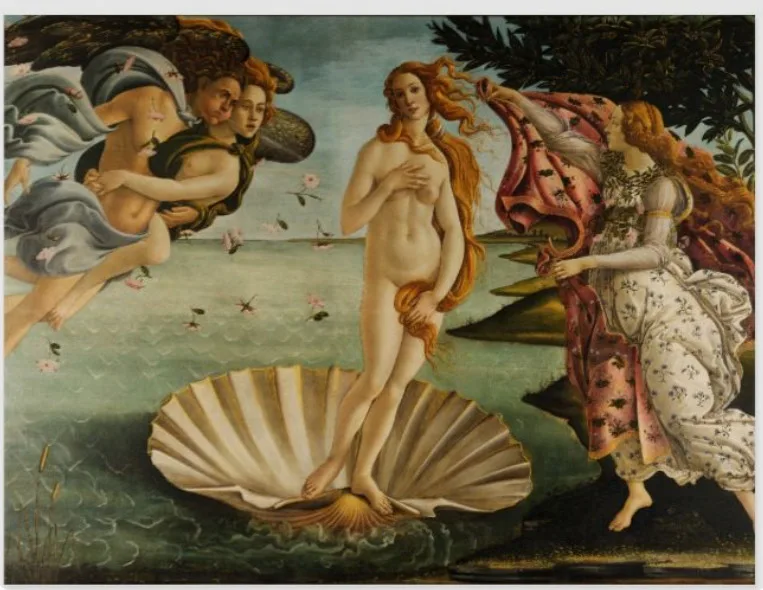
8.The Birth of Venus
Artist: Sandro Botticelli
The Birth of Venus by Sandro Botticelli is one of the most famous and iconic paintings in the world.
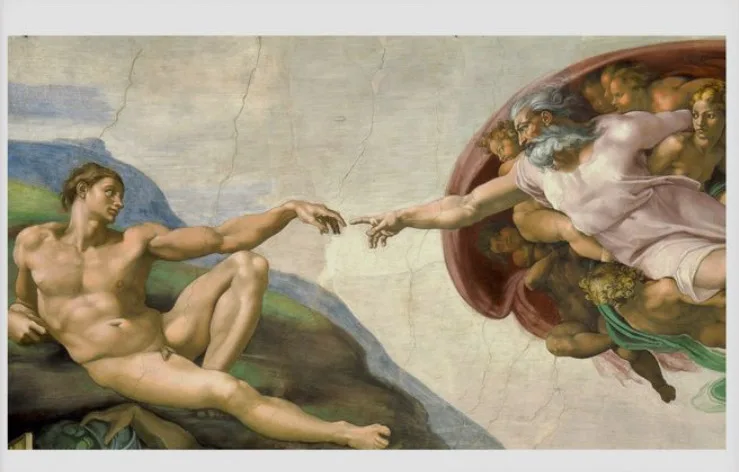
9.The Creation of Adam
Artist: Michelangelo
The Creation of Adam by Michelangelo is one of the most famous and iconic paintings in the world.
- Artist: Michelangelo Buonarroti, one of the greatest artists of the Italian Renaissance, created The Creation of Adam. Michelangelo is renowned for his work as a sculptor, painter, architect, and poet.
- Creation and Date: The painting was completed around 1512 and is part of the Sistine Chapel ceiling in Vatican City, which Michelangelo painted between 1508 and 1512.
- Subject Matter: The Creation of Adam depicts the biblical story from the Book of Genesis in which God gives life to Adam, the first man. The scene captures the moment just before their fingers touch, symbolizing the imparting of life.
- Composition and Figures: The painting features a dynamic and powerful composition. God is depicted as an elderly, muscular figure surrounded by angels, reaching out to Adam, who lies on the ground. The almost touching hands of God and Adam are the focal point of the composition.
- Symbolism: The painting is rich in symbolism. The outstretched hands represent the connection between the divine and humanity. God’s dynamic, forceful posture contrasts with Adam’s more passive, receptive pose, emphasizing the act of creation.
- Artistic Technique: Michelangelo’s use of fresco technique, with its vibrant colors and detailed rendering of human anatomy, showcases his mastery. The muscular forms and expressive poses of the figures highlight his knowledge of the human body and his sculptural background.
- Cultural Impact: The Creation of Adam has had a profound cultural impact and is one of the most reproduced and referenced artworks in history. It has become a symbol of human creation and divine touch.
- Location: The painting is located on the ceiling of the Sistine Chapel, one of the most visited sites in the world. The Sistine Chapel is part of the Vatican Museums, and millions of visitors come each year to see Michelangelo’s masterpiece.
- Artistic Legacy: The Creation of Adam has influenced countless artists and is a key work in the canon of Western art. Its composition, use of space, and depiction of the human form have been studied and admired for centuries.
- Philosophical and Theological Themes: The painting explores themes of creation, the relationship between God and humanity, and the transmission of life and knowledge. It reflects Renaissance humanism’s emphasis on the dignity and potential of humans.
- Michelangelo’s Vision: The painting is a testament to Michelangelo’s artistic vision and his ability to convey complex theological concepts through powerful imagery. It is part of a larger narrative sequence that tells the story of humanity’s fall and redemption.
- Restoration and Preservation: The Sistine Chapel ceiling, including The Creation of Adam, has undergone significant restoration to preserve its colors and details. These efforts have ensured that the painting remains vibrant and accessible to future generations.
- Emotional and Aesthetic Appeal: The dynamic interaction between God and Adam, coupled with the painting’s dramatic composition and exquisite detail, evokes a sense of awe and reverence. Its beauty and emotional power continue to captivate viewers.
- Iconic Status: The almost touching hands of God and Adam have become one of the most iconic images in art history. This detail alone is often used to symbolize creation, life, and the human connection to the divine.
- Educational Importance: The painting is widely studied in art history and theology courses. It provides insight into Michelangelo’s techniques, the cultural and religious context of the Renaissance, and the ways art can convey profound philosophical ideas.
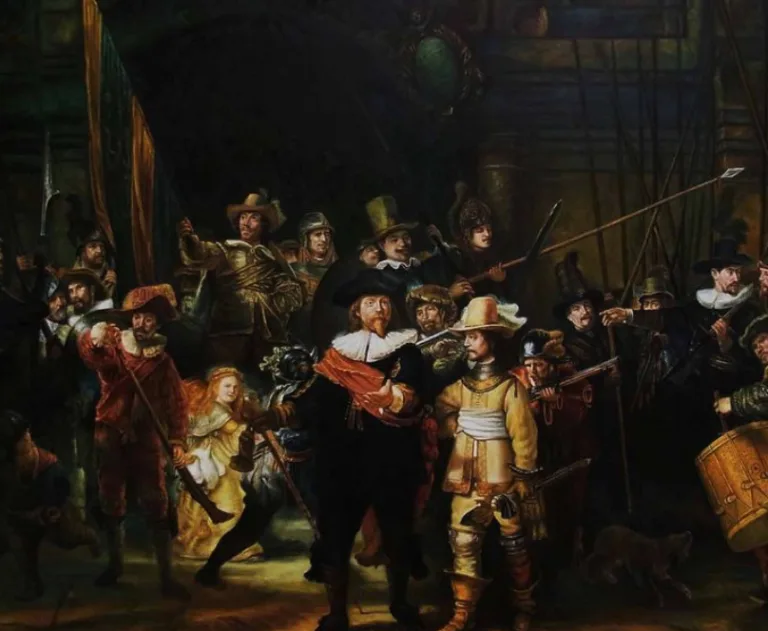
10.The Night Watch
Artist: Rembrandt van Rijn
The Night Watch by Rembrandt van Rijn is one of the most famous and iconic paintings in the world.
- Artist: Rembrandt van Rijn, one of the most celebrated Dutch painters of the Golden Age, created The Night Watch. Rembrandt is known for his masterful use of light and shadow, rich color palette, and detailed realism.
- Creation and Date: The painting was completed in 1642 and is formally titled Militia Company of District II under the Command of Captain Frans Banning Cocq, though it is commonly known as The Night Watch.
- Subject Matter: The painting depicts a group of Amsterdam’s civic militia or city guardsmen, led by Captain Frans Banning Cocq and his lieutenant, Willem van Ruytenburch. The scene captures the moment as they prepare to move out, creating a sense of action and dynamism.
- Composition and Figures: The Night Watch is renowned for its large scale and complex composition. The figures are arranged in a dynamic, almost chaotic manner, with prominent use of light and shadow to guide the viewer’s eye. The two central figures, Captain Cocq and Lieutenant van Ruytenburch, are highlighted by bright light, drawing immediate attention.
- Use of Light and Shadow: Rembrandt’s masterful use of chiaroscuro (the contrast between light and dark) adds depth and drama to the scene. This technique helps to create a sense of movement and three dimensionality, making the figures appear lifelike and animated.
- Symbolism: The painting includes numerous symbolic elements. For instance, the young girl in the foreground, illuminated by light, is believed to represent the mascot of the militia, carrying a chicken with prominent claws, symbolizing the Kloveniers (the name of the company). Various weapons and banners also have symbolic significance, reflecting the group’s identity and pride.
- Artistic Technique: Rembrandt’s use of oil paint allows for rich texture and detail. His ability to capture different materials, such as fabric, metal, and skin, with great realism showcases his technical prowess.
- Cultural Impact: The Night Watch is a cornerstone of Dutch cultural heritage and is considered one of Rembrandt’s greatest masterpieces. It has been referenced and studied extensively in art history and popular culture.
- Public Display: The painting is housed in the Rijksmuseum in Amsterdam, where it is one of the museum’s most prominent and visited works. The museum has dedicated significant resources to its display and preservation.
- Artistic Legacy: The Night Watch has influenced countless artists and remains a key work in the study of Baroque art and Dutch painting. Its innovative composition and use of light have set a benchmark for portrait and group paintings.
- Restoration and Preservation: The painting has undergone several restorations to address damage and aging. Recent conservation efforts have used advanced technology to study and preserve its intricate details, ensuring its longevity for future generations.
- Historical Context: The painting provides a glimpse into the civic life of 17th century Amsterdam, reflecting the importance of civic militias in maintaining order and protecting the city. It is also an example of how art was commissioned to celebrate and document these groups.
- Emotional and Aesthetic Appeal: The Night Watch’s dramatic composition, lifelike figures, and intricate details create a compelling and immersive viewing experience. Its ability to convey movement and emotion adds to its enduring appeal.
- Educational Importance: The painting is widely studied in art history courses for its technical and compositional innovations. It provides insight into Rembrandt’s artistic approach and the cultural and historical context of the Dutch Golden Age.
- Iconic Status: The Night Watch’s combination of artistic excellence and historical significance makes it one of the most recognizable and admired paintings in the world. Its presence in the Rijksmuseum continues to attract and inspire visitors from around the globe.

